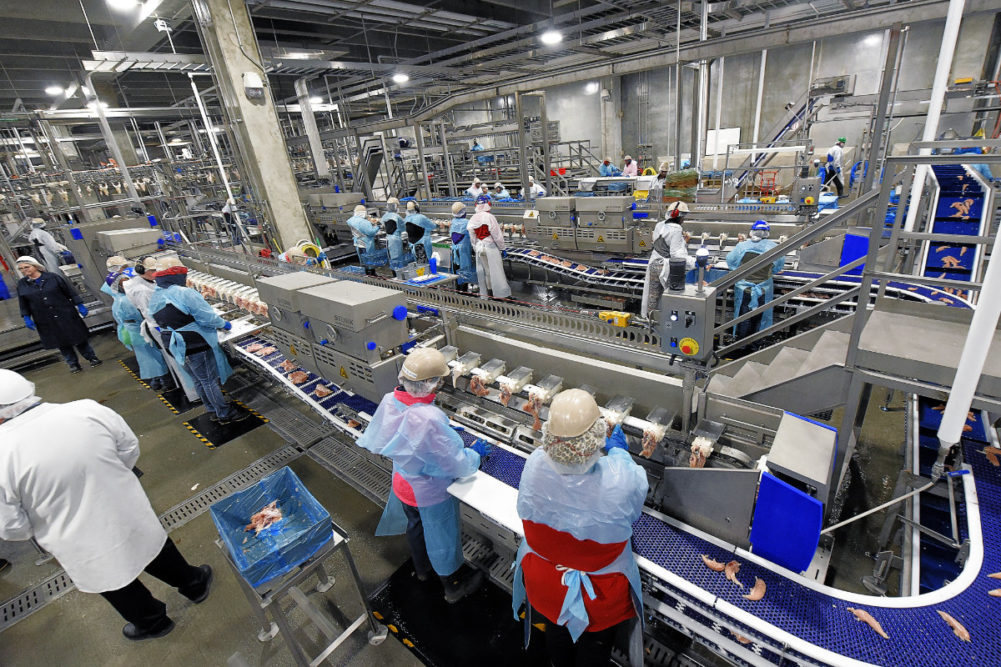ATLANTA – The Centers for Disease Control and Prevention (CDC) said at least 17,358 cases and 91 COVID-19-related deaths have occurred among US meat and poultry processing workers. The agency combined data on workers with COVID-19 and COVID-19-related deaths reported through May 31 from 23 states (16,233 cases; 86 deaths) with data from an earlier assessment through April 27 (1,125 cases; five deaths).
CDC said 12% of patients were asymptomatic or pre-symptomatic. However, many asymptomatic and pre-symptomatic infections in the overall workforce might have gone unrecognized because not all facilities performed facility-wide testing. Consequently, the report might underestimate the number of infections, the agency said.
CDC researchers also noted the disproportionate impact of the disease on racial and ethnic minorities who work in the meat processing industry. Among animal slaughtering and processing workers from the 21 states included in this report whose race/ethnicity were known, approximately 39% were white, 30% were Hispanic, 25% were black, and 6% were Asian.
“However, among 9,919 workers with COVID-19 with race/ethnicity reported, approximately 56% were Hispanic, 19% were black, 13% were white and 12% were Asian, suggesting that Hispanic and Asian workers might be disproportionately affected by COVID-19 in this workplace setting,” CDC said. “Ongoing efforts to reduce incidence and better understand the effects of COVID-19 on the health of racial and ethnic minorities are important to ensure that workplace-specific prevention strategies and intervention messages are tailored to those groups most affected by COVID-19.”
The United Food and Commercial Workers International Union (UFCW) repeated its call for stronger worker protections against the coronavirus.
“This new CDC report makes clear what UFCW has been saying for months. The COVID-19 pandemic is far from over and its impact on frontline workers — especially workers of color — is continuing to increase,” said Mark Lauritsen, UFCW International vice president. “American workers simply cannot survive with the current patchwork of safety measures put in place by a fraction of companies and states. Without a strong national standard, millions of workers are still unprotected and vulnerable.
“We need real enforcement of the highest safety standards for workers in meatpacking and other essential industries. We cannot continue to cross our fingers and hope for the best — government agencies have to act now to protect workers and keep our food supply secure.”
CDC acknowledged that the meat and poultry processing industry faces unique challenges in trying to control COVID-19 outbreaks among workers.
“Distinctive factors that increase meat and poultry processing workers’ risk for exposure to SARS-CoV-2, the virus that causes COVID-19, include prolonged close workplace contact with coworkers (within 6 feet for ≥15 minutes) for long time periods (8- to 12-hour shifts), shared work spaces, shared transportation to and from the workplace, congregate housing, and frequent community contact with fellow workers,” CDC researchers said. “Many of these factors might also contribute to ongoing community transmission.”
However, processors have implemented a variety of interventions to reduce transmission or prevent ongoing exposure within production facilities such as temperature checks for anyone entering a facility, installing workstation and breakroom dividers, and clearly marking appropriate 6-ft distances in common use areas, staggering start times to avoid large gatherings and assigning monitors to enforce social distancing. CDC reiterated the importance of workplace interventions in efforts to control spread of COVID-19.
“Collaborative implementation of interventions and prevention efforts, which might include comprehensive testing strategies, could help reduce COVID-19–associated occupational risk,” CDC said. “Targeted, workplace-specific prevention strategies are critical to reducing COVID-19-associated health disparities among vulnerable populations Lessons learned from investigating outbreaks of COVID-19 in meat and poultry processing facilities could inform investigations in other food production and agriculture workplaces to help prevent and reduce COVID-19 transmission among all workers in these essential industries.”


